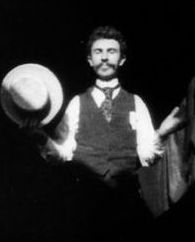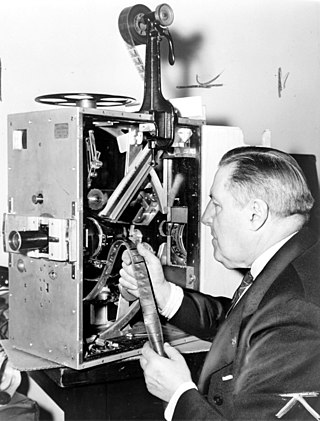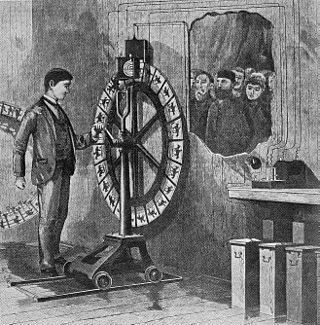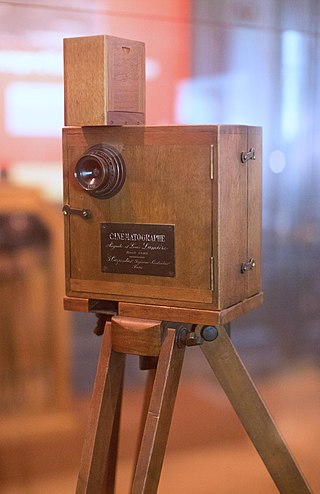Operation
The Mutoscope works on the same principle as the flip book. The individual image frames are conventional black-and-white, silver-based photographic prints on tough, flexible opaque cards. The image on each card is made by contact printing each frame of the original 70 mm film. [3] Rather than being bound into a booklet, the cards are attached to a circular core, similar to a huge Rolodex. A reel typically holds about 850 cards, giving a viewing time of about one minute. [4] The reel with cards attached has a total diameter of about 10 inches (25 cm); the individual cards have dimensions of about 2+3⁄4 in × 1+7⁄8 in (7.0 cm × 4.8 cm).
Mutoscopes are coin-operated. The patron views the cards through a single lens enclosed by a hood, similar to the viewing hood of a stereoscope. The cards are generally lit electrically, but the reel is driven by means of a geared-down hand crank. Each machine holds only a single reel and is dedicated to the presentation of a single short subject, described by a poster affixed to the machine.
The patron can control the presentation speed only to a limited degree. The crank can be turned in both directions, but this does not reverse the playing of the reel. The patron cannot extend viewing time by stopping the crank, because the flexible images are bent into the proper viewing position by tension applied from forward cranking. Stopping the crank reduces the forward tension on the reels causing the reel to go backward and the picture to move away from the viewing position. A spring in the mechanism turns off the light, and in some models closes a shutter which blocks the picture.
Manufacture
Mutoscopes were originally manufactured from 1895 to 1909 for the American Mutoscope Company, later American Mutoscope and Biograph Company (1899) by the Marvin & Casler Co., Canastota, New York formed by two of the founding Managers of American Mutoscope Company.
In the 1920s the Mutoscope was licensed to William Rabkin who started his own company, the International Mutoscope Reel Company, which manufactured new reels and also machines from 1926 until 1949.
The term "Mutoscope" is no longer a registered trademark in the United States.
Public response
The San Francisco Call printed a short piece about the Mutoscope in 1898, which claimed that the device was extremely popular: "Twenty machines, all different and amusing views...are crowded day and night with sightseers." [5] However, just a few months later, the same newspaper published an editorial railing against the Mutoscope and similar machines: "...a new instrument has been placed in the hands of the vicious for the corruption of youth...These vicious exhibitions are displayed in San Francisco with an effrontery that is as audacious as it is shameless." [6]
In 1899, The Times also printed a letter inveighing against "vicious demoralising picture shows in the penny-in-the-slot machines. It is hardly possible to exaggerate the corruption of the young that comes from exhibiting under a strong light, nude female figures represented as living and moving, going into and out of baths, sitting as artists' models etc. Similar exhibitions took place at Rhyl in the men's lavatory, but, owing to public denunciation, they have been stopped."

William Kennedy Laurie Dickson was a British inventor who devised an early motion picture camera under the employment of Thomas Edison.

Gottfried Wilhelm Bitzer was an American cinematographer, notable for his close association and pioneering work with D. W. Griffith.
The following is an overview of the events of 1895 in film, including a list of films released and notable births.

The Kinetoscope is an early motion picture exhibition device, designed for films to be viewed by one person at a time through a peephole viewer window. The Kinetoscope was not a movie projector, but it introduced the basic approach that would become the standard for all cinematic projection before the advent of video: it created the illusion of movement by conveying a strip of perforated film bearing sequential images over a light source with a high-speed shutter. First described in conceptual terms by U.S. inventor Thomas Edison in 1888, it was largely developed by his employee William Kennedy Laurie Dickson between 1889 and 1892. Dickson and his team at the Edison lab in New Jersey also devised the Kinetograph, an innovative motion picture camera with rapid intermittent, or stop-and-go, film movement, to photograph movies for in-house experiments and, eventually, commercial Kinetoscope presentations.

A stereoscope is a device for viewing a stereoscopic pair of separate images, depicting left-eye and right-eye views of the same scene, as a single three-dimensional image.

A peep show or peepshow is a presentation of a live sex show or pornographic film which is viewed through a viewing slot.

The Biograph Company, also known as the American Mutoscope and Biograph Company, was a motion picture company founded in 1895 and active until 1916. It was the first company in the United States devoted entirely to film production and exhibition, and for two decades was one of the most prolific, releasing over 3000 short films and 12 feature films. During the height of silent film as a medium, Biograph was the most prominent U.S. film studio and one of the most respected and influential studios worldwide, only rivaled by Germany's UFA, Sweden's Svensk Filmindustri and France's Pathé. The company was home to pioneering director D. W. Griffith and such actors as Mary Pickford, Lillian Gish, and Lionel Barrymore.

The Elektrischen Schnellseher or Electrotachyscope was an early motion picture system developed by chronophotographer Ottomar Anschütz between 1886 and 1894. He made at least seven different versions of the machine, including a projector, a peep-box viewer and several versions with illuminated glass photographs on a rotating wheel viewed on a 12.5 cm (4.9 in) wide milk glass screen by up to seven people at the same time.

Cinematograph or kinematograph is an early term for several types of motion picture film mechanisms. The name was used for movie cameras as well as film projectors, or for complete systems that also provided means to print films.

Vitascope was an early film projector first demonstrated in 1895 by Charles Francis Jenkins and Thomas Armat. They had made modifications to Jenkins' patented Phantoscope, which cast images via film and electric light onto a wall or screen. The Vitascope is a large electrically-powered projector that uses light to cast images. The images being cast are originally taken by a kinetoscope mechanism onto gelatin film. Using an intermittent mechanism, the film negatives produced up to fifty frames per second. The shutter opens and closes to reveal new images. This device can produce up to 3,000 negatives per minute. With the original Phantoscope and before he partnered with Armat, Jenkins displayed the earliest documented projection of a filmed motion picture in June 1894 in Richmond, Indiana.

Actuality film is a non-fiction film genre that uses footage of real events, places, and things, in a similar way to documentary film. Unlike documentaries, actuality films are not structured into a larger narrative or coherent whole. In practice, actuality films preceded the emergence of the documentary. During the era of early cinema, actualities—usually lasting no more than a minute or two and usually assembled together into a program by an exhibitor—were just as popular and prominent as their fictional counterparts. The line between "fact" and "fiction" was not as prominent in early cinema as it would become once documentaries became the predominant non-fiction filmmaking form. Actuality as a film genre is related to still photography.

The Kinora was an early motion picture device developed by the French inventors Auguste and Louis Lumière in 1895, while simultaneously working on the Cinematograph. It was patented in February 1896.

Herman Casler was an American inventor and co-founder of the partnership called the K.M.C.D. Syndicate, along with W.K-L. Dickson, Elias Koopman, and Henry Marvin, which eventually was incorporated into the American Mutoscope Company in December 1895.

The International Mutoscope Reel Company was an American amusement arcade company. They were formed in the early 1920s, to produce Mutoscope machines and the motion picture reels that the machines played. They continued to manufacture arcade machines, including the claw machine as well as electro-mechanical games, until 1949.
Mutoscope cards were still images, typically of pin-up material, printed on cards and sold through vending machines. Their dimensions were 5+1⁄4-by-3+1⁄4-inch and they were published during the 1940s by the International Mutoscope Reel Company and other firms. They are not individual pictures from Mutoscope reels and have no connection whatsoever to the Mutoscope motion-picture device. All carry the inscription "A Mutoscope card." They were sold from coin-operated vending machines in places such as amusement parks. Most Mutoscope cards are of pin-up material, but some featured other kinds of images such as Jimmy Hatlo cartoons.

Sherlock Holmes Baffled is an American silent trick film created in 1900 with cinematography by Arthur Marvin. It is the earliest known film to feature Arthur Conan Doyle's detective character Sherlock Holmes, albeit in a form unlike that of later screen incarnations. In the film, a thief who can appear and disappear at will steals a sack of items from Sherlock Holmes. At each point, Holmes's attempts to thwart the intruder end in failure.

The Latham Loop is used in film projection and image capture. It isolates the filmstrip from vibration and tension, allowing movies to be continuously shot and projected for extended periods.

Above the Limit is a short film made in November 1900 by Frederick S. Armitage. It marks the film debut of vaudevillian actor Charley Grapewin, 39 years before his better-remembered role as Dorothy's Uncle Henry in MGM's The Wizard of Oz. Created by the American Mutoscope and Biograph Company along with its sister film, Grapewin's Chimmie Hicks and the Rum Omelet, it was shot in September and October 1900 and released in November of that year for viewing in Mutoscope "Moving Picture Machines" as a tale sharing the pitfalls of gambling.

Norman C. Raff and Frank R. Gammon were two American businessmen who were known for distributing and promoting some of the Edison Studio films, and founding their own business, which was called The Kinetoscope Company.



















